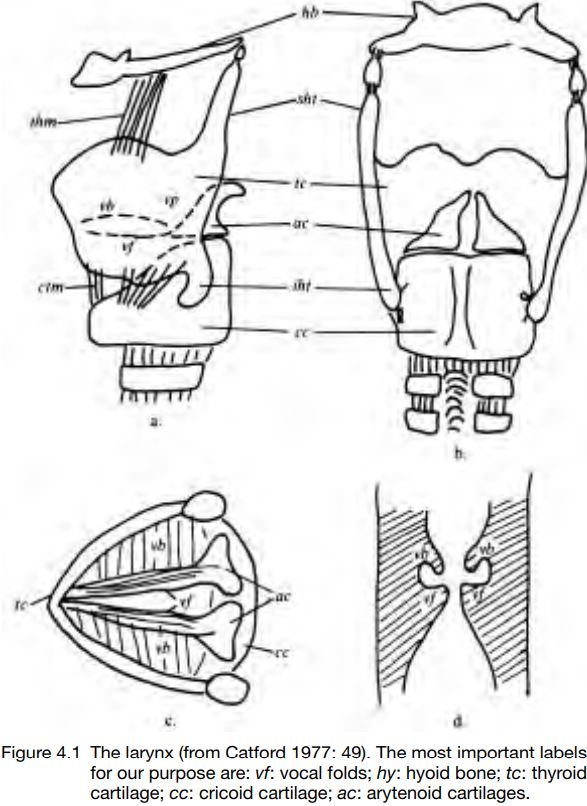


 Grammar
Grammar
 Tenses
Tenses
 Present
Present
 Past
Past
 Future
Future
 Parts Of Speech
Parts Of Speech
 Nouns
Nouns
 Verbs
Verbs
 Adverbs
Adverbs
 Adjectives
Adjectives
 Pronouns
Pronouns
 Pre Position
Pre Position
 Preposition by function
Preposition by function 
 Preposition by construction
Preposition by construction
 Conjunctions
Conjunctions
 Interjections
Interjections
 Grammar Rules
Grammar Rules
 Linguistics
Linguistics
 Semantics
Semantics
 Pragmatics
Pragmatics
 Reading Comprehension
Reading Comprehension|
Read More
Date: 9-6-2022
Date: 2023-06-06
Date: 16-6-2022
|
The larynx, voicing and voice quality
We will look at the production of voicing, the construction of the larynx, and the mechanism which gets the vocal folds vibrating. We will then move on to look at ways this vibration can be controlled to produce different pitches and voice qualities.
Good examples of pairs of sounds distinguished by voicing in English are [s f] (voiceless) and [z v] (voiced). Produce a [s] or [f] sound; close your eyes and concentrate on how it feels to produce this sound; and then make a [z] or [v] sound instead. Now produce chains of sounds like [s z s z s …] or [f v f v …] without inserting a pause between them. If you put your fingers in your ears, you will notice a humming or buzzing for [z v] which is not there for [s f]. With the fingers resting very lightly on your larynx, you will notice that [z v] involve a vibration that you do not feel for [s f].
Voicing is produced when the vocal folds vibrate. The vocal folds are located in the larynx (Figure 4.1), which sits just below where your jaw meets your neck. For males, there is a rather prominent notch at the front of the larynx, and it is a couple of centimeters below the jawbone; for females, the larynx is less prominent and may be a bit higher up the neck. If you watch yourself in a mirror, you will probably be able to see your larynx bob down and then up again as you swallow.
The larynx is constructed from three main cartilages: the thyroid, cricoid and arytenoid cartilages. Of these three, the thyroid is the most obvious. It is the largest and is at the front of the larynx, and forms the ‘box’ of the larynx. It consists of two plates which are joined at an angle at the front. Female thyroids are at a wider angle than male thyroids, so the notch where the plates meet is more obvious in males than in females. The thyroid cartilage is attached by muscles to the hyoid bone higher up in the neck.

The cricoid cartilage is a sort of ring shape underneath the thyroid. It forms the bottom part of the ‘box’. It has two spurs at the back, one on each side, which reach up to behind the bottom part of the thyroid. The two artytenoid cartilages sit on top of the back of the cricoid cartilage. They can move together and apart, rock backwards and forwards as well as rotate.
The vocal folds are two ligaments (fibrous tissues) which are covered in mucous membrane. They are attached to the arytenoids at the back and the thyroid at the front. At the side, they are attached to muscle in the larynx. In the middle they are free, so that there is a gap or a space between them, known as the glottis. The arytenoids can move, but the thyroid is static; by manipulating the arytenoids, the tension across the vocal folds can be changed, as can their thickness and the way they vibrate.
|
|
|
|
4 أسباب تجعلك تضيف الزنجبيل إلى طعامك.. تعرف عليها
|
|
|
|
|
|
|
أكبر محطة للطاقة الكهرومائية في بريطانيا تستعد للانطلاق
|
|
|
|
|
|
|
أصواتٌ قرآنية واعدة .. أكثر من 80 برعماً يشارك في المحفل القرآني الرمضاني بالصحن الحيدري الشريف
|
|
|